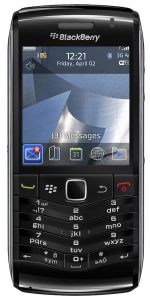
The BlackBerry Pearl 3G, more formally known as the BlackBerry 9105, is Research in Motion’s boldest product since the Bold 9700.
BlackBerry devices have always tended to conjure up images of businessmen and women, hacking away at e-mail on practical Qwerty keyboards.
Research in Motion’s consumer-friendly Pearl 3G is likely to break this stereotype, without skimping on all the essential features of a BlackBerry smartphone. Even without the traditional Qwerty keyboard, it rivals the best in the BlackBerry stable.
The Pearl range of devices is probably the one line of BlackBerrys that has long been in need of a makeover. They have sported the same design and functionality since 2006 and have always been considered the entry-level device.
So, the Pearl 3G is a real breath of fresh air. It feels more like a miniature version of the superb Bold handset rather than an upgrade to the Pearl 8100. It uses the same processor as the new Bold and comes with the matching features like 3G, Wi-Fi support and a 3,2-megapixel camera. It even supports GPS, something the entry-level devices have not done before.
The Wi-Fi takes a little work to get right and, like the Bold, takes some time to connect.
The device supports a wide variety of mobile data networks, including 3G networks at 900MHz. So those consumer users hoping to make use of Cell C’s upcoming third-generation broadband network will be able to browse at high speeds using this phone.

The Pearl is not short in the elegance department and the candy bar-shaped device has some excellent design features. It weighs only 93g. That’s so light that you might consider it a fragile device, and you would be right. A protective case is a definite must for Pearl 3G users.
One thing Research in Motion used to get right was easy access to the battery and Sim card slots. On the Bold there is a nice slide-out back that is easily removed. And on the Javelin, there is a clasp that will release the back for easy access. However, the new Pearl 3G has none of these niceties and we found that getting access to the battery and Sim slot was really a bit of a pain.
The screen size is the same as other phones of its size, coming in at 2,2-inches, with a 360×400-pixel display.
The small screen makes browsing on the Internet a little frustrating. BlackBerry OS5 does not wrap its browsing content, which is problematic even on a bigger screen than the one found on the Pearl 3G.
The most interesting change is the non-Qwerty keyboard input, which will have many BlackBerry traditionalists howling. Having said that, the new predictive text technology from Research in Motion, called SureType, has solved the traditional problems these types of keyboards used to represent. Finding the word that you are looking to type is easier and it also checks your spelling as you type.
However, SureType is not perfect, and it’s harder to add words to the dictionary than when using BlackBerry’s Qwerty software. It is also harder to use certain text input applications without the traditional BlackBerry keyboard.
However, the non-Qwerty keyboard may be a welcome addition for consumers that have not got their fingers around a smartphone before.
Research in Motion’s foray into the consumer market is getting off to a good start, though its ultimate success locally will depend on the price point of the product.
The company does not have local pricing yet, so it’s difficult to say what kind of consumer the company is targeting.
It hasn’t released the phone to local consumers yet, and it can’t say when it expects to have deals in place with the local operators.
When it does come to market, though, don’t be put off by its small size. The Pearl 3G packs all the punch of the top-end BlackBerry devices. — Candice Jones, TechCentral
- Subscribe to our free daily newsletter
- Follow us on Twitter or on Facebook

